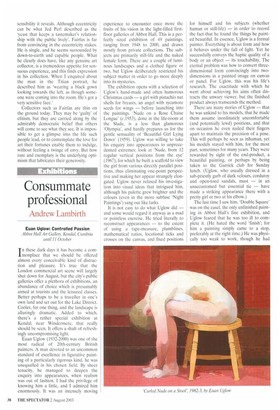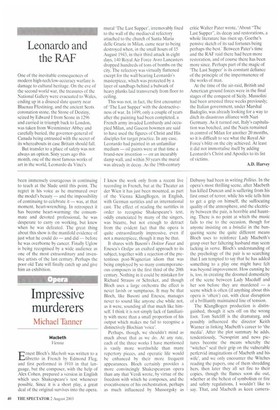Consummate professional
Andrew Lambirth
Euan Uglow: Controlled Passion Abbot Hall Art Gallery; Kendal, Cumbria until II October
In these dark days it has become a commonplace that we should be offered almost every conceivable kind of distraction and pleasure. It's true that the London commercial art scene will largely shut down for August, but the city's public galleries offer a plethora of exhibitions, an abundance of choice which is presumably aimed at tourists and the leisured classes. Better perhaps to be a traveller in one's own land and set out for the Lake District. Cooler, for one thing, and the landscape is alluringly dramatic. Added to which, there's a rather special exhibition at Kendal, near Windermere, that really should be seen. It offers a shaft of refreshingly uncompromising light.
Euan Uglow (1932-2000) was one of the most radical of 20th-century British painters. A man devoted to an uncommon standard of excellence in figurative painting of a particularly rigorous kind, he was unequalled in his chosen field. By sheer tenacity, he managed to deepen the enquiry into appearances, when realism was out of fashion. I had the privilege of knowing him a little, and I admired him enormously. It was an intensely moving experience to encounter once more the fruits of his vision in the light-filled firstfloor galleries of Abbot Hall. This is a perfectly sized exhibition of 49 paintings, ranging from 1948 to 2000, and drawn mostly from private collections. The subjects are primarily still-life and the naked female form. There are a couple of luminous landscapes and a clothed figure or two, but Uglow deliberately restricted his subject matter in order to go more deeply into its mysteries.
The exhibition opens with a selection of Uglow's hand-made and often humorous Christmas cards — a girl with pistachio nut shells for breasts, an angel with sycamore seeds for wings — before launching into the paintings. 'Nude on a Rose Chaise Longue' (c.1953), done in the life-room at the Slade, is a less than glamorous 'Olympia', and hardly prepares us for the gentle sensuality of 'Beautiful Girl Lying Down' (1959). Uglow was willing to take his enquiry into appearances to unprecedented extremes: look at 'Nude, from 12 regular vertical positions from the eye' (1967), for which he built a scaffold to view the girl from various directly parallel positions, thus eliminating one-point perspective and making her appear strangely elongated. Uglow never relaxed his investigation into visual ideas that intrigued him, although his palette grew brighter and the colours (even in the more subfuse `Night Paintings') sang out like larks.
It is not easy to do what Uglow did — and some would regard it anyway as a mad or pointless exercise. He tried literally to reconstruct appearances --to the extent of using a tape-measure, plumblines, mathematical ratios, locational ticks and crosses on the canvas, and fixed positions
for himself and his subjects (whether human or still-life) — in order to record the fact that he found the things he painted beautiful. In essence, Uglow is a formal painter. Everything is about form and how it behaves under the fall of light. Yet he successfully conveys the haptic quality of a body or an object — its touchability. The eternal problem was how to convert threedimensional form convincingly into twodimensions in a painted image on canvas or panel. For Uglow, this was his life's research. The exactitude with which he went about achieving his aims often distracts the unwary viewer, but the finished product always transcends the method.
There are many stories of Uglow — that he was unkind to his models, that he made them assume inordinately uncomfortable (and potentially lewd) positions, and that on occasion he even nailed their fingers apart to maintain the precision of a pose. This will perhaps be seen as inhuman, yet his models stayed with him, for the most part, sometimes for many years. They were rewarded by sight of the end-product, a beautiful painting, or perhaps by being taken to the Garrick club for Sunday lunch. (Uglow, who usually dressed in a sub-priestly garb of dark velours, corduroy and open-toed sandals, must — in an unaccustomed but essential tie — have made a striking appearance there with a pretty girl or two at his elbow.) The last time I saw him, 'Double Square' was on the easel, the only unfinished painting in Abbot Hall's fine exhibition, and Uglow feared that he was too ill to complete it. (He hated the word 'finish'; for him a painting simply came to a stop, preferably at the right time.) He was physically too weak to work, though he had been immensely courageous in continuing to teach at the Slade until this point. The regret in his voice as he murmured over the model's beauty and the impossibility of continuing to celebrate it — was, at that moment, heart-wrenching. In retrospect it has become heart-warming: the consummate and devoted professional, he was desperate to carry on working, but knew when he was defeated. The great thing about this show is the manifold evidence of just what he could do — and did — before he was overborne by cancer. Finally Uglow is being recognised by a wide audience as one of the most extraordinary and inventive artists of the last century. Perhaps the poor old Tate will finally catch up and give him an exhibition.



























































 Previous page
Previous page